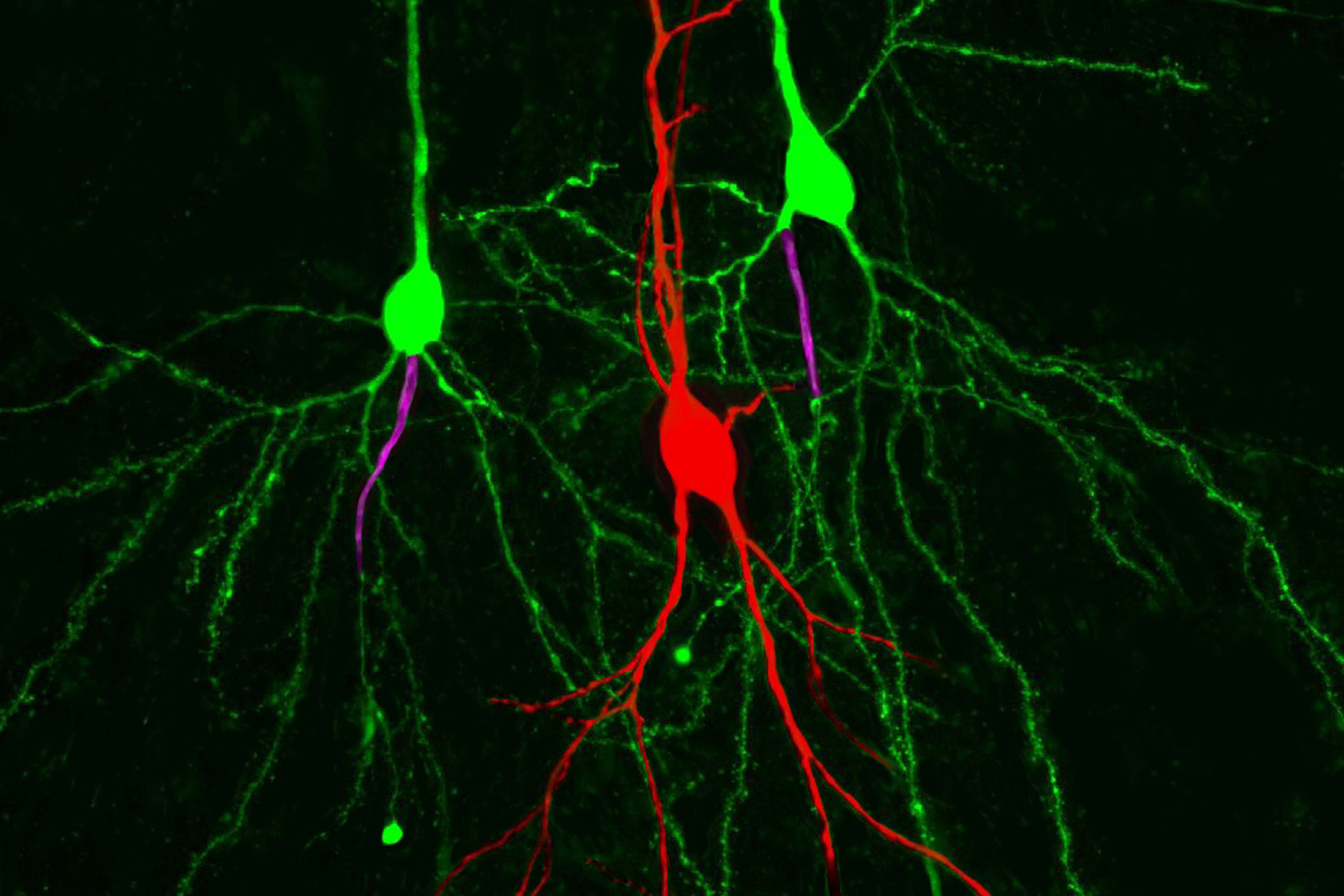Information processing in standby mode: How certain neurons circumvent forced pauses
Researchers from Heidelberg, Linz and Tübingen describe a new mechanism of signal transmission in the hippocampus, the memory center of the brain: Stimulus transmission past the cell body works despite inhibition by neuronal network. Their findings were published in the journal Science.

Pyramidal cells in the hippocampus (green): In the left cell, the axon (pink) arises directly from the cell body; in the right cell, it arises from the dendrites. © Heidelberg University Hospital
Bernstein member involved: Andreas Draghun
Stimuli received via the antennae, then processed in the cell body, and only then passed on via the output line: not all nerve cells in the brain follow this signal transfer sequence described in textbooks, as researchers from the Medical Faculty of Heidelberg (MFHD) and the Universities of Linz and Tübingen recently reported in the scientific journal “Science”. About half of the neurons in the hippocampus, the memory center of the brain, circumvent their activity rhythm prescribed by the neuronal network by means of a “signal short circuit”: The incoming signals do not even pass through the cell body, but reach the output line directly from the antennae. Thus, they remain active even when all other nerve cells are inhibited by the network and take a forced rest. It is still unclear what effects this mechanism has on the organism as a whole. It is possible that the brain ensures in this way that important information is not lost.
The “standard neuron” consists of the finely branched dendrites, which resemble the branches of a tree and serve as signal antennas, the cell body and the output line that originates from it, the axon. Signals are transferred to the subsequent nerve cells via the axon. At the dendrites and the cell body, the nerve cell receives excitatory and inhibitory signals, which are integrated and processed at the cell body. Only when excitation outweighs inhibition, the signals – described in simplified terms – are transmitted via the axon. In this way, the brain protects itself from overload, because not every incoming stimulus is equally relevant.
A team of scientists led by Dr. Martin Both, group leader in the Department of Neuro- and Sensory Physiology at the Institute of Physiology and Pathophysiology of the MFHD, investigated certain cells in the hippocampus that deviate in their anatomy from this classical pattern: in about half of these “pyramidal neurons” – as the group has shown in previous work – the discharging axon originates directly at an antennal branch of the dendrites rather than at the cell body. “We wondered whether these pyramidal neurons evade the inhibitory stimuli which target the cell body due to their special anatomy” Dr. Both explained. Direct inhibition of the cell body, for example, in the form of regularly triggered resting periods, plays an important role in the synchronization of signal processing and transfer between brain areas.
Experiments in mice, mouse brain slices, and simulations in mathematical models showed that the pyramidal neurons with input-output shortcut passed on signals more frequently than the “regularly” constructed cells, despite inhibition or standby mode of the network. “The mechanism seems to be more significant the stronger the inhibition of the pyramidal neurons. Because then, only these special cells with axon-carrying dendrites are active, while their colleagues are asleep,” Both said. “We don’t know yet which information is so important that it is passed on via these special neurons despite the neurons being in a general resting period.”
The hippocampi are located at the base of each hemisphere of the brain. They are responsible for both knowledge and spatial memory and play an important role in transferring memories from short-term to long-term memory. To do this, they transfer information to the cerebral cortex. How the two hippocampi synchronize their activity is not fully understood. “It is possible that the cells we studied are responsible for maintaining communication between the brain hemispheres. But further research will have to show that,” says the neurophysiologist.




